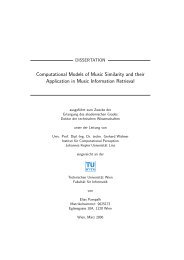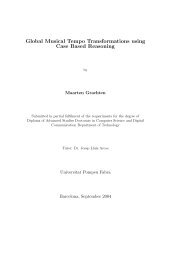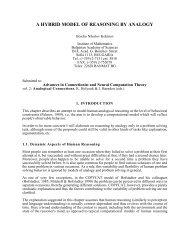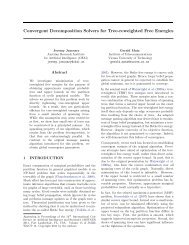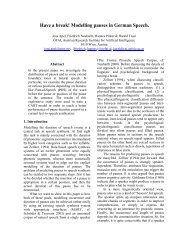First Suggestions for an Emotion Annotation and ... - OFAI
First Suggestions for an Emotion Annotation and ... - OFAI
First Suggestions for an Emotion Annotation and ... - OFAI
You also want an ePaper? Increase the reach of your titles
YUMPU automatically turns print PDFs into web optimized ePapers that Google loves.
scriptors to use, <strong>an</strong>d even less on the exact labels that<br />
should be used. EARL has to provide me<strong>an</strong>s <strong>for</strong> using different<br />
sets of categorical labels as well as emotion dimensions<br />
<strong>an</strong>d appraisal-based descriptors of emotion.<br />
Intensity of <strong>an</strong> emotion, to be expressed in terms of numeric<br />
values or discrete labels.<br />
Regulation type, which encodes a person’s attempt to regulate<br />
the expression of her emotions (e.g., simulate, hide,<br />
amplify).<br />
Scope of <strong>an</strong> emotion label, which should be definable by<br />
linking it to a time sp<strong>an</strong>, a media object, a bit of text, a certain<br />
modality etc.<br />
Combination of multiple emotions appearing simult<strong>an</strong>eously.<br />
Both the co-occurrence of emotions as well as the<br />
type of relation between these emotions (e.g. domin<strong>an</strong>t vs.<br />
secondary emotion, masking, blending) should be specified.<br />
Labeller confidence expresses the labeller’s degree of confidence<br />
with the emotion label provided.<br />
In addition to these in<strong>for</strong>mation types included in the list of<br />
requirements, a number of additional items were discussed.<br />
Roughly these c<strong>an</strong> be grouped into in<strong>for</strong>mation about the<br />
person (i.e. demographic data but also personality traits),<br />
the social environment (e.g., social register, intended audience),<br />
communicative goals, <strong>an</strong>d physical environment (e.g.<br />
constraints on movements due to physical restrictions).<br />
Though the general usefulness of m<strong>an</strong>y of these in<strong>for</strong>mation<br />
types is undisputed, they are intentionally not part of the<br />
currently proposed EARL specification. If needed, they<br />
have to be specified in domain-specific coding schemes that<br />
embed EARL. It was decided to draw the line rather strictly<br />
<strong>an</strong>d concentrate on the encoding of emotions in the first<br />
place, in order to ensure a small but workable representation<br />
core to start with. The main rational to justify this restrictive<br />
approach was to first provide a simple l<strong>an</strong>guage <strong>for</strong><br />
encoding emotional states proper, <strong>an</strong>d to leave out the factors<br />
that may have led to the actual expression of this state.<br />
Thus, EARL only encodes the fact that a person is, e.g.,<br />
trying to hide certain feelings, but not the fact that this is<br />
due to a specific reason such as social context. Clearly,<br />
more discussion is needed to refine the limits of what<br />
should be part of EARL.<br />
PROPOSED REALISATION IN XML<br />
We propose <strong>an</strong> extendable, XML-based l<strong>an</strong>guage to <strong>an</strong>notate<br />
<strong>an</strong>d represent emotions, which c<strong>an</strong> easily be integrated<br />
into other markup l<strong>an</strong>guages, which allows <strong>for</strong> the mapping<br />
between different emotion representations, <strong>an</strong>d which c<strong>an</strong><br />
easily be adapted to specific applications.<br />
Our proposal shares certain properties with existing l<strong>an</strong>guages<br />
such as APML [10], RRL [8], <strong>an</strong>d EmoTV coding<br />
scheme [3], but was re-designed from scratch to account <strong>for</strong><br />
the requirements compiled from theory <strong>an</strong>d use cases. We<br />
used XML Schema Definition (XSD) to specify the EARL<br />
grammar, which allows us to define abstract datatypes <strong>an</strong>d<br />
extend or restrict these to specify a particular set of emotion<br />
categories, dimensions or appraisals.<br />
The following sections will present some core features of<br />
the proposed l<strong>an</strong>guage, using illustrations from various<br />
types of data <strong>an</strong>notation.<br />
Simple emotions<br />
In EARL, emotion tags c<strong>an</strong> be simple or complex. A simple<br />
uses attributes to specify the category, dimensions<br />
<strong>an</strong>d/or appraisals of one emotional state. <strong>Emotion</strong> tags<br />
c<strong>an</strong> enclose text, link to other XML nodes, or specify a time<br />
sp<strong>an</strong> using start <strong>an</strong>d end times to define their scope.<br />
One design principle <strong>for</strong> EARL was that simple cases<br />
should look simple. For example, <strong>an</strong>notating text with a<br />
simple “pleasure” emotion results in a simple structure:<br />
Hello!<br />
Annotating the facial expression in a picture file<br />
face12.jpg with the category “pleasure” is simply:<br />
<br />
This “st<strong>an</strong>d-off” <strong>an</strong>notation, using a reference attribute, c<strong>an</strong><br />
be used to refer to external files or to XML nodes in the<br />
same or a different <strong>an</strong>notation document in order to define<br />
the scope of the represented emotion.<br />
In uni-modal or multi-modal clips, such as speech or video<br />
recordings, a start <strong>an</strong>d end time c<strong>an</strong> be used to determine<br />
the scope:<br />
<br />
Besides categories, it is also possible to describe a simple<br />
emotion using emotion dimensions or appraisals:<br />
<br />
<br />
EARL is designed to give users full control over the sets of<br />
categories, dimensions <strong>an</strong>d/or appraisals to be used in a<br />
specific application or <strong>an</strong>notation context (see below).<br />
In<strong>for</strong>mation c<strong>an</strong> be added to describe various additional<br />
properties of the emotion: <strong>an</strong> emotion intensity; a confidence<br />
value, which c<strong>an</strong> be used to reflect the (hum<strong>an</strong> or<br />
machine) labeller’s confidence in the emotion <strong>an</strong>notation; a<br />
regulation type, to indicate <strong>an</strong> attempt to suppress, amplify,<br />
or simulate the expression of <strong>an</strong> emotion; <strong>an</strong>d a modality, if<br />
the <strong>an</strong>notation is to be restricted to one modality.<br />
For example, <strong>an</strong> <strong>an</strong>notation of a face showing simulated<br />
pleasure of high intensity:<br />
<br />
In order to clarify that it is the face modality in which a<br />
pleasure emotion is detected with moderate confidence, we<br />
c<strong>an</strong> write:




